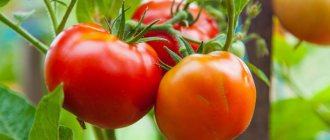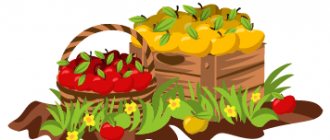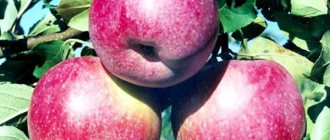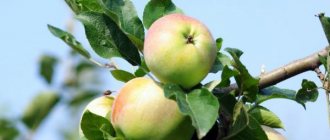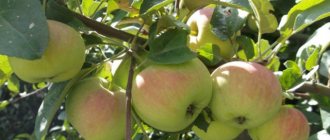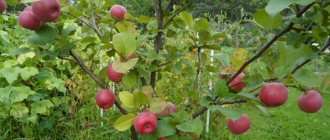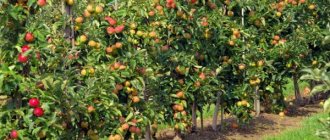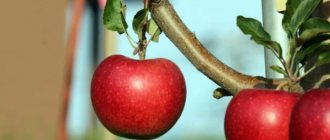The White Pouring apple tree is deservedly considered one of the most popular ancient varieties. These summer apples, which are among the first to ripen, are associated among domestic amateur gardeners with pleasant memories of the unique refreshing taste and aroma of early fruits from their childhood, for which many are ready to forgive the variety for all its flaws and shortcomings.
Apple tree "White filling" (pictured) is a traditional variety of crop, long grown in the central part of Russia and the Volga region
The main characteristic features of the variety are given in the table:
| Parameter | Characteristic |
| Culture | Apple tree (Malus domestica Borkh.) |
| Variety | “Pouring white” (Alabaster, Dolgostebelka, Pouring white real, Pouring through, Pouring white, Alabaster pipka, Pudovshchina) |
| Tree height | Medium height: 3-5 meters |
| Type of root system depending on the rootstock | With a powerful central rod in vigorous-growing ones; highly branched, without a central core in low-growing ones (on dwarf and semi-dwarf rootstocks) |
| Terms of ripening and consumption | Early summer |
| Removable (technical) maturity | Last ten days of July – second ten days of August |
| Fruit shelf life | 15-20 days |
| Precociousness | Average: 5-7 years |
| Type of fruiting | Mixed |
| Productivity of an adult tree per season | Above average: about 110 kg, sharply periodic |
| Size and weight of fruits | Small or medium - from 100 to 120 g |
| Shape and color | The apples are round-conical or ovoid, slightly ribbed, often with a sharp longitudinal “seam”. The skin is thin, smooth, shiny and covered with a waxy coating; the main color is soft white (sometimes with a dull tan). Subcutaneous dots are gray and green, barely noticeable |
| Fruit pulp | White, loose, fine-grained, aromatic |
| Tasting assessment (taste qualities) | 4.1-4.6 points (out of 5) – pleasant, wine-sour taste |
| Purpose of fruits | Dining room (universal) |
| Sustainability | High winter hardiness and frost resistance; severely affected by scab |
| Year of inclusion in the State Register of the Russian Federation | 1947 |
| Recommended growing regions | Northwestern (2) |
| Originator | Federal State Budgetary Institution "All-Russian Selection and Technological Institute of Horticulture and Nursery Growing" (Moscow) |
History of the variety's creation
The White filling variety has quite a long history. It appeared in connection with folk selection. It is believed that it was bred in the Baltic countries and then spread throughout Europe, but some experts talk about it as an old Russian variety.
In general, the variety does not have an author; it has been cultivated for a very long time both in Central Russia and the Volga region. This plant was first described in 1848 by the gardener N.A. Krasnoglazov in his work “Rules of Fruit Growing.”
In 1947, White filling was included in the register of breeding achievements of the Russian Federation. With his participation, more than 20 other varieties of apples were developed.
Main characteristics
Apple trees usually do not grow higher than 5 meters. At first the crown looks like a pyramid, but later it becomes rounded. The bark also has its own specificity that distinguishes this variety from the rest: it is usually light gray and somewhat rough, although in places it can be smooth (exclusively in young individuals).
The leaves are medium in size, elliptical in shape, pubescent below, smooth above. They are colored gray-green, although the leg is lighter. During flowering, you can see large white petals interspersed with pink. Since the flowers are large, the apple tree can be pollinated by the wind, without the participation of insects.
The fruit ripens early; in mid-latitudes, the harvest can be harvested as early as early August and finished by the end of the month. In the south, apples ripen in July. In northern latitudes - at the end of August.
It is worth noting that the variety survives the winter without problems and can hold the ovary if the temperature suddenly drops in the spring. However, in cold climates you should not expect a harvest from it. In the northern regions the tree will not survive.
Description of fruits
During intensive fruiting, apples are of medium size, weighing a maximum of 120 grams. In young individuals, the weight of the fruit can reach 150 grams, in old ones it can decrease to 60. The stalk does not hold firmly on the branch. The shape of apples is round-conical, sometimes it can be wide and ovoid. The funnel is deep and has a small width.
The color of the fruit is green; as it ripens, it turns white. If the tree is illuminated by the sun, then a pink blush appears on the apples on the south side. On one side of the fruit there is a seam from the tail to the calyx. There may be a white residue on it when it sets, but this can easily be wiped off or washed off.
The skin of apples is thin and slightly sour, different from the tender pulp. The fruits are best suited for making jam, marmalade, juice or wine, and significantly less sugar can be added to the preparation. The composition is as follows: 10% pectin and 9% sugar.
If an apple is overripe, it will taste mealy and not juicy enough, but the aroma will remain the same. The fruit itself is quite delicate; even a small scratch or damage will cause rotting. It is best to pick by hand, as if you shake the tree, the apples may break and turn brown at the point of impact.
The harvest can be stored for no more than three weeks. Every day it loses its properties, even if it was collected in an unripe form. Fruits do not like transportation; it is better to store them in high containers, since the lower apples can be crushed.
White filling is especially valued by gardeners who are not aiming for sale, but for consumption or quick processing.
Apple recipes
From White filling you can prepare various dishes for every taste.
Apple jam
To make delicious jam for the winter, you only need apples and sugar. Fruits should be washed, peeled, cored, and cut into cubes. Sugar is taken in a 1:1 ratio. Pour in the prepared fruits and leave overnight to allow the juice to appear. Place on the stove and cook over low heat after boiling for at least 2 hours. Stir occasionally to prevent the jam from burning. Pour hot into sterile jars and seal. After complete cooling, place in a cool, dark place for storage.
Apple jam
Peel the apples, remove the middle, cut into small cubes. Add sugar in a 1:1 ratio. Cover with a lid and leave for half an hour to release the juice. Place on the stove. After boiling, leave for 10 minutes, turn off the heat, and let cool completely. Repeat the procedure again. So 2 times. On the third, cook longer, beating the apples into a puree. When they turn golden, add a little cinnamon. Pour into sterile jars. The jam turns out thick, aromatic, very tasty.
Pollinator trees
There are several pollinating trees that contribute to the formation of the fruits of the White Fill apple tree. It is advisable to take varieties that bloom and produce crops at the same time as this variety. Here are some of them:
- Anise;
- Mantet;
- Grushovka.
- Mac;
- Antonovka;
- Quinty;
- Golden Delicious;
- Champion.
Mantet
Mac
Golden Delicious
Features of cultivation in different regions
- In the Moscow region, white filling is ubiquitous. Apple trees of this variety are found in almost all gardens. They are loved for their early ripeness and are forgiven for their poor keeping quality and lack of transportability.
- In the southern regions the variety is also very common. Here apple trees bloom and bear fruit several weeks earlier compared to the middle zone.
- In Siberia, apples grow small, weighing 60-90 g. Trees begin to bear fruit no earlier than 5-6 years of age.
Productivity
The fruits ripen for the first time 5 years after planting the seedling, sometimes this period can be a little longer. Usually up to 200 kilograms of harvest are harvested from one tree, and final ripening should be expected by mid-August.
Of course, this requires proper care of the tree. It is worth remembering that as the apple tree grows older, it loses productivity. To maintain the size of the fruits, it is necessary to thin out the ovaries and flowers.
Diseases and pests
The White Fill apple tree can suffer from various diseases and pests, so first of all you need to pay great attention to prevention. Experienced gardeners recommend doing the following:
- collect and dispose of plant debris and weeds;
- It’s good to dig up the soil in the autumn;
- thin out the crown and carry out sanitary pruning;
- remove damaged bark, then whiten the trunk and skeletal branches;
- attach catcher belts to the boles.
Scab
The apple tree is not immune to this disease, which develops against the background of high humidity and excessively dense plantings, as well as unthinned crowns. The symptoms of the disease are as follows:
- The upper part of the leaf is covered with large spots of a dark green hue. Over time they turn brown. If the plant is severely damaged, then natural processes are distorted, causing the foliage to fall.
- The fruits are covered with dark spots with a velvety coating, the flesh becomes very coarse. At an early stage, apples may be ugly and stunted in development. An advanced disease provokes the loss of at least half of the crop.
For prevention, the tree can be treated with biofungicides throughout the season. If the scab has gone far, you will have to use chemicals. In autumn and early spring, Bordeaux mixture (3%) is used for processing.
Powdery mildew
This disease manifests itself as a dirty white coating on young foliage, shoots and inflorescences. In mid-summer, the leaves curl and fall, the shoots become distorted and die.
Apples often suffer from a rusty network running into the flesh. It must be treated in the same way as for scab, within the same time frame. Colloidal sulfur added to a solution with fungicides shows excellent results in the fight against powdery mildew.
Dangerous pests
- The codling moth is the most popular crop pest. Caterpillars devour seeds and pulp; if you do not fight them, there is a chance of losing up to 90% of the harvest. You can get rid of it using insecticides.
- Green aphids love foliage and green shoots. The leaves curl, the shoots suffer from deformation and gradually dry out. Severely weakens the tree. You can get rid of it by treating the plant with insecticides after bud break.
- Apple flower beetle. The larvae devour the receptacle, causing the death of the buds. To get rid of them, insecticides are used, which are used to treat the plant during the period of bud break and when the beetles emerge from the buds.
codling moth
Green aphid
Apple flower beetle
Answers to readers' questions
Rusty leaves on an apple tree
Apple rust is a fungal disease. The spores overwinter as a reddish-brown mass on young juniper branches. In early spring, during rains, the spores are carried away by the wind and infect apple trees. Spores from apple trees will only infect juniper next year. From year to year the disease should move from juniper to apples and again to juniper.
After flowering, apple trees develop pale yellow spots the size of a pinhead on the upper surface of the leaves. They gradually increase to bright orange-yellow spots. Orange spots may also develop on fruits. Infected leaves drop prematurely.
Fighting the disease
- Plant resistant varieties.
- Rake and dispose of fallen leaves and other debris from under trees.
- Remove the yellow substance from infected junipers, or the juniper itself.
- Apply fungicides. Spray juniper with a copper solution at the rate of 14-56 g per 5 liters of water, 4 times from the end of August to the end of October.
- Use medications containing sulfur. If the weather is humid, mix 100 g in 5 liters of water. Spray all parts of the plant thoroughly, especially new shoots.
Why do apple trees bear fruit after a year?
Exhaustion
When the apple tree bears fruit abundantly, the tree becomes depleted. The next year the harvest decreases or the apple tree begins to bear fruit after a year. It is necessary to thin out young fruits at the beginning of summer so that next year's harvest will be normal. Remove the smallest fruits. Leave one for each bunch. One fruit for every 40-75 leaves, the fruit should be evenly distributed along the branch.
Poor care
Lack of water or nutrients reduces the apple tree's yield and causes the trees to bloom and fruit excessively the following year.
Adverse weather conditions
Apple trees that lose color during a storm or cold snap tend to bear fruit within a year.
Variety varieties
There are varieties of apple trees that are more prone to such fruiting than others. Early maturing varieties are also at risk and require careful thinning.
Other reasons
Poor pollination and improper pruning. Many apple trees require a compatible partner for successful pollination. The absence of flowers on one tree, perhaps due to bad weather or the tree dying or being cut down, can lead to a decrease in fruit on its pollinating partner. You can also prune areas of the tree where fruit grows. This refers to trees that have fruits at the ends of their stems.
How to pick apples from a tall apple tree
You can buy devices in a store or make them yourself. The most common fruit collectors are made from plastic bottles. To do this, cut out the bottom of a 2-liter bottle and make a V-shaped cut. Wrap tape around the edge to strengthen it and place it on the pole. Bring it to the apple, grab it and cut it with a rotational motion. It's in a container.
You can make another device from 3 pipes of different lengths. They connect together. At the end, on top, there is a wire grip with rings. A fishing line is inserted into them, which is used for clamping. The device is brought to the fruit, the fishing line is pulled, and the apple ends up in the container. For these purposes, devices with bags and baskets are used.
Advantages and disadvantages
White filling has advantages that set it apart from other varieties:
- rich harvest, up to 200 kilograms per tree;
- earlier fruiting, already 5 years after planting;
- copes with winter frosts without problems;
- Harvesting can begin as early as August;
- apples can be eaten fresh, in the form of juices and canned food.
Of course, there are some disadvantages that are important to consider before planting an apple tree:
- fruits do not tolerate transportation;
- The harvest can be stored for no more than 3 weeks;
- large volumes of crops simply cannot be processed in a short time;
- fruiting periodically;
- is afraid of rotting; any damage to the fruit almost always leads to spoilage.
Types of rootstocks
The crop is grown on different rootstocks and has different types.
Semi-dwarf
Below a medium-sized tree, grows up to 4 meters in height. Very frost-resistant, in other respects it is similar to plants of a dwarf rootstock.
Dwarf
A low-growing tree, 3 meters high. Can be planted among tall plants. The roots are upland and are not afraid of nearby groundwater.
Productivity is higher than that of other species. It will begin to bear fruit in 2-3 years.
creeping
The most frost-resistant species, low-growing, is cultivated in Siberia.
White filling is widely used in breeding. Varieties developed on its basis:
Landing
It is best to plant an apple tree in autumn or spring, and in the latter case it will take root faster. As for the location, it is best to choose an area with a slight southern or southwestern slope, which is well lit and protected from the cold wind. There should be no groundwater nearby to prevent the tree from rotting. The soil should not be clayey.
Planting algorithm:
- Form a hole 80 centimeters deep and 1 meter wide.
- Make a small mound of earth there.
- Place the apple tree in the soil and dig in. Compact the soil.
- Drive a couple of pegs around the edges and tie a young plant to them.
- Pour in plenty of water.
Care
To ensure that the apple tree always remains healthy and pleases its owners with its harvest, you should remember a few simple rules of care:
- The apple tree needs to be watered once every 10 days if there is no rain.
- The soil around the trunk needs to be loosened regularly.
- It is advisable to prune the branches annually to maintain good yield and reduce breakage.
- The tree needs regular fertilization.
Feeding
To make the tree bear fruit faster and feel better, it is permissible to use potassium and phosphate fertilizers, as well as urea. It is advisable to start fertilizing from the second year after planting.
Urea is added continuously at the rate of 2 tablespoons per 10 liters of water; it cannot be used in the fall, as it worsens wintering. In September, a solution of water and superphosphate in a similar proportion works well.
You can also use manure, bird droppings or a solution of wood ash with microelements for fertilizer. The tree is fed about 3-4 times a year.
Trimming
In order for the crown to take shape, it is necessary to prune every year. The young plant is cut at a height of 90 centimeters, this promotes the development of lateral branches. As the crown develops, it will be necessary to cut off the side shoots that extend far towards the trunk. They are cut at a distance of 50-70 centimeters.
It is also advisable to cut branches that grow correctly to the third bud. Sanitary pruning is carried out early in the spring, before the sap begins to flow through the tree.
As soon as the apple tree begins to bloom, several small apples are tied in each bunch. To increase the size of the fruit, you can remove the central fruit from each bunch.
Reproduction
White filling is propagated in the same ways as all apple trees.
Propagation by seeds
Mainly used by breeders. Such trees need to be pollinated properly.
Special knowledge required.
Through vaccinations
This is the most common method of propagating apple trees. Young shoots of the first year of life are used as a scion.
Often grafted to the root of a tree - wildflower.
Root cuttings
They are used as seedlings. To do this, the roots of the tree are covered with soil at a height of 20 cm above the ground. This is where the finished seedlings grow. In the fall they can be planted in a new place.
By layering
To do this, bend the lower stems and allow them to take root, covering them with soil. Then they are planted in their place.
We recommend watching a video that tells about an interesting way of propagating fruit trees - by air layering.
Broken branch
Annual branches are cut and buried to a depth of 10 cm. Weeds are removed and watered constantly until the branch gives roots. In the fall they are transplanted to a permanent place.
Reviews
Daria, 60 years old: The White filling variety is my favorite. The fruits appear very early, and their taste and aroma are indescribable. In general, we thought for a long time about what kind of apple tree to plant, and a neighbor gave us a seedling of this variety. We have never regretted it yet! Caring for the plant is not difficult, just water and prune on time, and fertilize. Tolerates winter well. I am pleased!
Anatoly, 70 years old : In general, I like the White filling apple tree. It is not too fussy to care for; the harvest from my two trees is simply huge. The whole family is happy. The only sad thing is that the fruits cannot be stored for a long time; they spoil very quickly. We try to collect as quickly as possible and prepare for the winter. The taste is excellent.
Features of cultivation
Selection of seedlings
It is recommended to select white seedlings from seedling centers or nurseries.
When choosing, be sure to pay attention to the roots: they must be healthy and strong, without thickening or swelling, mechanical damage, or moldy areas.
Ideally suited are seedlings at least 1.5 meters high, with a straight trunk, five skeletal branches and a healthy, strong root collar. It is also not recommended to take seedlings that are too tall; there is a high probability that such trees will take root poorly and will often get sick.
How to transport a tree?
The roots of the seedling are carefully wrapped with a wet cloth and placed in a plastic bag. You can prepare a very moist substrate. The branches are lightly tied.
If planting is not planned immediately, but after a few days or weeks, leave the seedling in a bag of wet soil or dig it in.
Choosing the time and place of rooting
The most suitable time for planting white filling is the beginning of May . By this time the earth should be sufficiently warmed up. Spring planting is especially recommended for young specimens under two years of age.
More mature trees take root in the fall, at the beginning of October. The roots of the seedlings are left in water for a day before planting. During planting, water the soil generously until it stops absorbing moisture.
An important factor is the choice of landing site:
- White filler should not be planted in the shade or in strong winds . There should be no other trees nearby; the minimum distance between trees in the garden is four meters. Permissible groundwater level: 2.5 - 3m.
The ideal soil for the variety is non-acidic chernozem enriched with nutrients and minerals. Moderately clay soil may also be suitable .
Do not plant apple trees on swampy or rocky soil: even if they take root, they will often get sick and may die.- After the place for the apple tree has been chosen, you need to prepare it.
This should be done 4 weeks before planting the seedling. You should dig a hole 60-70 cm deep, 80-90 cm in diameter. In this case, it is recommended to set aside the top and bottom layers of soil separately. This is important, since planting will be carried out only with soil from the top layer of soil, which is more fertile. Expanded clay or broken bricks are laid at the bottom of the pit. They drive in a small peg, first burning its lower edge. Fill the hole with a mixture of topsoil, humus, peat, compost and wood ash. Cover with film. If planting is done in the fall, it is enough to add only humus and ash.
Landing
In a month you can plant:
- Check the roots for damage. Damaged areas are cut off, and the sections are treated with crushed coal. Soak in water for a day.
- Lower the seedling into the hole. The peg should be located on the south side of the trunk to prevent spring bark burns.
- Carefully straighten the roots and cover the seedling with fertile soil. The soil is thoroughly compacted. During the process, the trunk is shaken to avoid voids between the roots. Make sure that the root collar is located approximately 5 cm above ground level.
- The trunk is tied to a support peg
- Water the seedling with about three buckets of water.
- Mulch the soil around the trunk to retain moisture. Mulch thickness - 5 cm.
Replanting a tree after planting in open ground is carried out only if absolutely necessary.
How to trim and shape the crown?
When planting a seedling in spring, the crown is formed before planting or immediately after it . If planted in autumn, then the first formative pruning is carried out next spring:
- The trunk is cut at a height of approximately 80 cm.
- The side branches are cut off by about a third.
- Damaged branches are removed.
Further, sanitary pruning will be carried out every year: in the spring, before the sap begins to flow, old and diseased branches are removed.
The first 3 - 4 years after planting, the crown of the tree is formed . During this period, formative pruning should be done. For white filling, a sparsely tiered crown is recommended. Number of tiers - 2 or 3.
The crown should be formed from 5-6 skeletal branches extending from the trunk at an angle of 60-70 degrees. Branches extending at a smaller angle are bent with a weight or twine.
Fertilizer application
Fertilizer application for the White filling variety is carried out according to the standard scheme for apple trees. During spring digging, organic fertilizer (humus/compost) is added. Norm: 5-7 kg per 1 sq. m.
Mineral fertilizers are applied every year:
- in spring - urea or carbamide (30-40 g per 1 sq. m.);
- during the period of fruit formation , then after 2-3 weeks - a solution of potassium monophosphate (10-20 g per 1 sq. m.);
- in the fall , during digging - superphosphate (30-40g per 1 sq. m.);
- in summer they feed with manure - liquid mullein or diluted chicken droppings.
